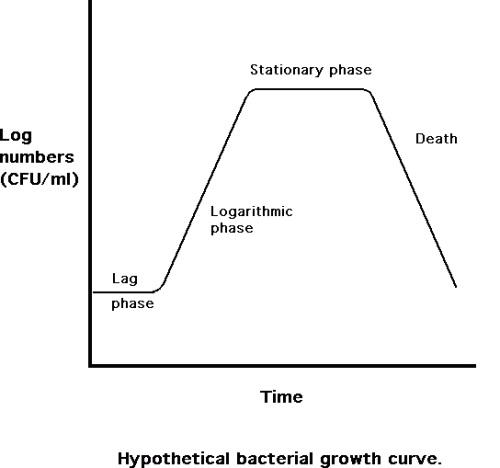Dairy Microbiology
15 Basic Microbiology
Microorganisms

There are several classes of microorganisms, of which bacteria and fungi (yeasts and moulds) will be discussed in some detail. Another type of microorganism, the bacterial viruses or bacteriophage, will be examined in a later section.
Bacteria
- Cocci:
- spherical shape
- 0.4 – 1.5 µ m
Examples: staphylococci – form grape-like clusters; streptococci – form bead-like chains.
- Rods:
- 0.25 – 1.0 µ m width by 0.5 – 6.0 µ m long
Examples: bacilli – straight rod; spirilla – spiral rod
There exists a bacterial system of taxonomy, or classification system, that is internationally recognized with family, genera and species divisions based on genetics.
Some bacteria have the ability to form resting cells known as endospores. The spore forms in times of environmental stress, such as lack of nutrients and moisture needed for growth, and thus is a survival strategy. Spores have no metabolism and can withstand adverse conditions such as heat, disinfectants, and ultraviolet light. When the environment becomes favourable, the spore germinates and giving rise to a single vegetative bacterial cell. Some examples of spore-formers important to the food industry are members of Bacillus and Clostridium generas.
Bacteria reproduce asexually by fission or simple division of the cell and its contents. The doubling time, or generation time, can be as short as 20-20 min. Since each cell grows and divides at the same rate as the parent cell, this could under favourable conditions translate to an increase from one to 10 million cells in 11 hours! However, bacterial growth in reality is limited by lack of nutrients, accumulation of toxins and metabolic wastes, unfavourable temperatures and desiccation. The maximum number of bacteria is approximately 1 X 10e9 CFU/g or ml.
Note: Bacterial populations are expressed as colony forming units (CFU) per gram or millilitre.

Bacterial growth generally proceeds through a series of phases:
- Lag phase: time for microorganisms to become accustomed to their new environment. There is little or no growth during this phase.
- Log phase: bacteria logarithmic, or exponential, growth begins; the rate of multiplication is the most rapid and constant.
- Stationary phase: the rate of multiplication slows down due to lack of nutrients and build-up of toxins. At the same time, bacteria are constantly dying so the numbers actually remain constant.
- Death phase: cell numbers decrease as growth stops and existing cells die off.
The shape of the curve (shown on the right) varies with temperature, nutrient supply, and other growth factors. This exponential death curve is also used in modeling the heating destruction of microorganisms.
Yeasts
- budding: called Fungi Imperfecti or false yeasts
- budding and spore formation: called Ascomycetes or true yeasts
Unlike bacterial spores, yeast form spores as a method of reproduction.
Moulds
Asexual Reproduction:
- fragmentation – hyphae separate into individual cells called arthropsores
- spore production – formed in the tip of a fruiting hyphae, called conidia, or in swollen structures called sporangium
Sexual Reproduction: sexual spores are produced by nuclear fission in times of unfavourable conditions to ensure survival.
Microbial Growth

- nutrient content
- moisture content
- pH
- available oxygen
- biological structures
- antimicrobial constituents
Nutrient Requirements
- water
- energy source
- carbon/nitrogen source
- vitamins
- minerals
Milk and dairy products are generally very rich in nutrients which provides an ideal growth environment for many microorganisms.
Moisture Content
pH
Available Oxygen
- Obligate Aerobes: oxygen required
- Facultative: grow in the presence or absence of oxygen
- Microaerophilic: grow best at very low levels of oxygen
- Aerotolerant Anaerobes: oxygen not required for growth but not harmful if present
- Obligate Anaerobes: grow only in complete absence of oxygen; if present it can be lethal
Biological Structures
Antimicrobial Constituents
- lactoperoxidase
- lactoferrin
- lysozyme
- xanthine
More information on these antimicrobials can be found in the dairy microbiology textbook by Marth and Steele. See also the discussion on lactoperoxidase in this series here.
Where the intrinsic factors are related to the food properties, the extrinsic factors are related to the storage environment. These would include temperature, relative humidity, and gases that surround the food.
Temperature
- Psychrotrophs: optimum growth temperatures 20 to 30° capable of growth at temperatures less than 7° C. Psychrotrophic organisms are specifically important in the spoilage of refrigerated dairy products.
- Mesophiles: optimum growth temperatures 30 to 40° C; do not grow at refrigeration temperatures
- Thermophiles: optimum growth between 55 and 65° C
It is important to note that for each group, the growth rate increases as the temperature increases only up to an optimum, after which it rapidly declines.

